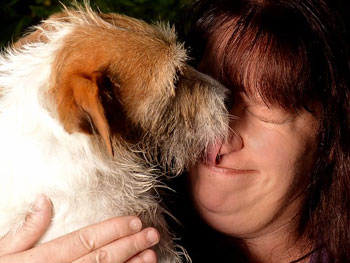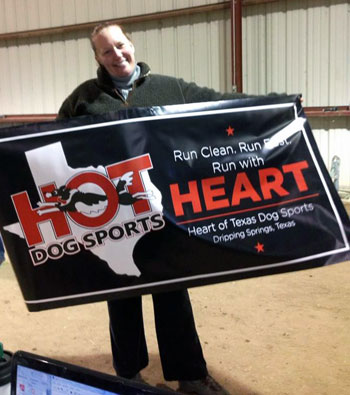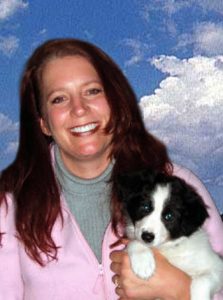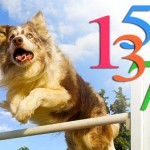Running with Heart
Interview with Shawn Cossart.

Shawn Cossart
Austin, TX area dog agility trainer, Shawn Cossart, was teaching classes in dog behavior when she first became interested in agility. Since starting her journey she’s grown to be a top local trainer and local agility event planner. With classes, seminars and events, HOT Dog Sports is one of the leading area resource for all things agility. Learn more about Shawn Cossart and her path to becoming a vital agility resource.
Interview Questions & Answers
Shawn, When did you begin competing in agility and what led you there?
In 1995 I was teaching behavior classes for Dr. Ian Dunbar in California and another trainer told me we should check out this thing called agility. With my rescue dog “Georgia” in tow we went to our first class. My poor little rescue was so afraid of the world and wasn’t cut out for agility. So after a lot of consideration, I decided to get a Jack Russell, “Attila”, and the agility fun began!
At that time, when you were brand new to agility, what did you find most challenging?
Back then the most challenging thing was learning to speak a new language… front cross, rear cross, reverse flow pivot. It was like learning a foreign language. Also learning the moves were not easy either. I remember practicing a front cross over and over again without my dog. Step forward, pivot, step. I learned a lot of handling moves with just plain practice, no dog.
Would you have done anything different in your choice of dog, training methods or competition choices?
While I would not change a thing for me I wouldn’t necessarily recommend starting your agility career with a Jack Russell Terrier unless you have lots of training experience. It was a blast but it was also a lot of work. I remember one of our first trials he ran out of the ring, onto the hillside and put his head in a gopher hole. It was pretty funny but a training challenge for sure!
I was very fortunate in where I lived when I started agility. There were many top instructors and seminars. So I studied from as many as I could. So I was very lucky in my education and training.
With respect to my competition choices the one thing that sticks out in my mind that I did that I try to impart on others is: when you come out of the ring, find what you did good and dwell on that, compliment that. I don’t know why I did that, who taught me that technique but it is very powerful to find what you did great and celebrate those things. I think that is why my early competition days were so fun!
What other challenges have you faced through the years?
As my business has grown my biggest challenge has been finding time to train my own dogs and train myself!
Also, in addition to teaching 12 classes a week and hosting seminars, I also host trials. I have a wonderful group of people that help with hosting the trials but the biggest challenge in that arena is finding an affordable venue on the open dates available.
With so many things to juggle: training your dogs; teaching classes; organizing seminars; event planning; running events; (You also have a secular job and a family), how do you maintain the physical and mental stamina for it all? What keeps you moving?
Yes, I also work a “day job” too, managing a legal department. What keeps me moving is a good question. I have always worked multiple jobs and/or school so being overly busy is something I think I’ve always done. My philosophy is “well, what else would I be doing, sitting around?” Although now I think I might be busier than I ever have been in the past. My students drive me. The love of helping other people is what I think keeps me going. I teach classes for the love of teaching. I host shows for the love of the sport, to promote the sport.
When did you start teaching and how did that come about?
I started teaching behavior training in 1995. My original background and education are in behavior, which I truly enjoy. Agility training formally began in 2007 with just two very small classes. Today HOT Dog Sports has 15 classes per week.
In what way do you feel your behavior training has given you an advantage for your agility training?
I believe my behavior training gives me an advantage because I can use those techniques to make the training a fun game for the dogs. Some folks just lure the dogs onto the equipment. I can use many positive reinforcement games to play with the dogs and before we know – they have agility skills, all by playing games or just positive training.
How did you come to developing and opening Heart of Texas Dog Sports? www.heartoftexasdogsports.com
In 2007 I was chatting with a friend of mine about the lack of classes in the various areas around Austin and the fact that there were no agility seminars in central Texas. Being from California we had lots and lots of seminars so to have none – I was going through withdrawals! That conversation led to the planning of classes and seminars! If you want something, go get it!! In 2007 classes began followed by our first seminar in February 2008.
As a coach, what do you find most rewarding about your job? Alternately, most challenging?
The most rewarding aspect of my job is that my students view me as a coach and not just an instructor. I love watching my students grow and succeed. Going to a trial and watching your students run their dogs like two seasoned dance partners is the most rewarding thing to experience.
The most challenging aspect of being an instructor is finding a way to explain something so all the students understand what your saying. Everyone learns differently so finding the right combination of techniques to convey a message is probably the most challenging. But, when you finally figure out the right way – it then becomes rewarding.
What would you consider your biggest accomplishment to date?
My biggest accomplishment is the success of my students. When they say “I couldn’t have done it without you!” that to me is my biggest accomplishment. I also feel a big accomplishment is my ability to train and compete with a wide variety of dogs. I’ve owned and competed with several different breeds, both large and small, easy and not so easy.
What dogs have you competed with through the years?
I have competed with Jack Russells, a Sheltie, Border Collies, Miniature American Shepherd, mutts, a Pug and many other students’ dogs. I take pleasure in running a variety of breeds!
What lesson have you learned from each that carried forward to the next?
Every dog is different and you learn new lessons from each dog. What training techniques you used with one dog may not work for the next even if they are the same breed. And, one dog never replaces the next. They are all very, very special little beings and we should appreciate each one for their own individual gifts. And we should appreciate those gifts often.
How do you feel the sport of dog agility has changed through the years? for the good and worse?
The sport of dog agility is ever changing and yet very much staying the same. While there seems to be new training “systems” in today’s world of agility with new moves and new terms. However, the moves aren’t all that different from the days of old. Now, that’s not to say there aren’t better ways of handling now than before but there is still something to be said for the good old “meat and potatoes” approach.
The most significant changes for the good are the changes in focus on K9 fitness and safety. More handlers are realizing that K9 health and fitness play a large role in their success in the ring. With the dogs getting more fit, faster and more agile, the need for equipment safety moved to the forefront and some great changes have been made to the safety of agility equipment.
With regard to ‘new moves’ & ‘new terms’, do you feel a handler can be competitive with more simple methods, can they compete at a higher level?
Absolutely! While new moves are great, and I love to learn them, one of the top handlers in the world, Stuart Mah, handles and consistently wins with good old fashion handling and verbals. I think whatever you do, if you do it consistently, you will succeed.
How have your dogs and training methods changed throughout the years?
My training methods are probably ever changing. I try to be a student of the game. I love attending seminars and learning new ideas and methods. My training style is a mash-up of what I’ve learned from many, many instructors both in the behavior world as well as the agility world.
How has the breed of dog you’ve worked with changed your training approach, if any?
Breed and/or personality may dictate how you train a dog. The key is finding what the dog finds rewarding and using that as your reward. For example, my JRT’s love to hunt more than anything. If they ran with me as soon as the run was over we ran out of the ring and went to go find gophers, or some other little critter. We may not have found any critters but it was the fun of the hunt my dogs loved. You will oftentimes see me today run out of the ring, run out of the building, to play with my dog – and every game is different.
What do you wish your students would take away most importantly from their lessons?
It’s ok not to be perfect. Have fun, love your dog, love the journey. Lessons are just that, lessons. It’s an ever-changing progression on your journey as a team. You will make mistakes and you will be brilliant. Oh and REWARD your dog!
What advice would you give people just starting to compete at agility trials?
If you are going to classes and have a good instructor ask for their advice on competing. If you don’t have a person to turn to look to see who you admire when competing and ask them for some tips and advice. Most people in agility would love to help others and they are a wealth of information.
Do you still get nervous before a run? how do you manage? what advice would you give your students?
I do still get nervous at the big events and sometimes the local events too. I also study mental management and read every book I can on mental management and how top athletes manage the mental part of the game.
What do you hope to achieve in competition, short range and long range? Hopes and dreams for you and your dogs?
I hope to be a champion of my dogs and the sport and to always have fun with my dogs. My hopes and dreams are happy, healthy dogs. As far as competition goals, I would like to be competitive on a national basis and once again make finals at Nationals and this time, make the podium.
What goals do you have for your business?

Shawn Cossart – Heart of Texas Dog Sports
My business goals are to be a valuable resource to the agility community for continuing education and agility related events.
What would you say are your strengths as a trainer, competitor and business owner?
As a trainer I think I’m a great problem solver. With a background in behavior I can usually find a way to teach almost anything the student is looking for, for example, teaching drive to a non motivated dog, or teaching a dog that is fearful, etc. Also, because I too am a student of the game with a diverse background in instruction from various trainers I have many techniques up my sleeve to help my students.
My strengths as a competitor is my never give up attitude!
As a business owner I strive to enhance the classes, seminars and trials I provide to the agility community.
Enjoy some favorite Shawn Cossart competition videos
Find out more about Shawn Cossart at
www.heartoftexasdogsports.com
If you have an idea for an interview, let me know.
stephanie@thatsmysuperdog.com








